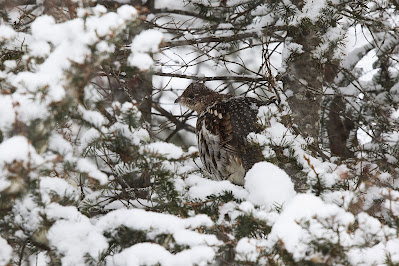Northern Treasures!
Ruffed Grouse:
Ruffed Grouse are usually found in mixed deciduous and coniferous forest interiors. They also live along forested streams and in areas growing back following burning or logging. They are fairly small with a short, triangular crest, short legs and a long, fan-shaped tail.
https://www.allaboutbirds.org/guide/Ruffed_Grouse/overview
In the northern part of their range, Ruffed Grouse depend on snow as a wintertime roost, burying themselves at night in soft drifts that provide insulating cover. The toes of Ruffed Grouse grow projections off their sides in winter, making them look like combs. The projections are believed to act as snowshoes to help the grouse walk across snow! The lower photo shows likely sleeping quarters from the night before.
https://www.allaboutbirds.org/guide/Ruffed_Grouse/overview
In much of their range, Ruffed Grouse populations go through 8 to 11 year cycles of increasing and decreasing numbers. Their cycles can be attributed to the Snowshoe Hare cycle. When hare populations are high, predator populations increase too. When the hare numbers go down, the predators must find alternate prey and turn to grouse, decreasing their numbers.
https://www.allaboutbirds.org/guide/Ruffed_Grouse/overview
Ruffed Grouse are considered a "bell weather species" that reflects the overall health of the environment. By improving habitat for ruffed grouse, food and cover are enhanced for the hundreds of other game and non-game species of wildlife that share the grouse's forest home!
http://www.rgs.ca/
In the winter, watch for Ruffed Grouse feeding on deciduous tree buds in bare treetops along roadsides. How far will they go to get the last bud on the branch??
https://www.hww.ca/wildlife/birds/ruffed-grouse/








No comments:
Post a Comment